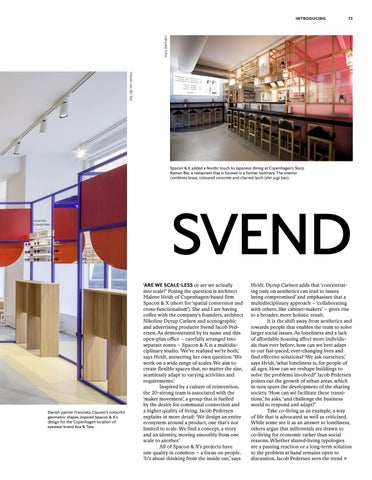73
Hans Bærholm
INTRODUCING
Wouter van der Star
Spacon & X added a Nordic touch to Japanese dining at Copenhagen’s Slurp Ramen Bar, a restaurant that is housed in a former butchery. The interior combines brass, coloured concrete and charred larch (shō sugi ban).
SVEND Danish painter Franciska Clausen’s colourful geometric shapes inspired Spacon & X’s design for the Copenhagen location of eyewear brand Ace & Tate.
‘ARE WE SCALE-LESS or are we actually into scale?’ Posing the question is architect Malene Hvidt of Copenhagen-based firm Spacon & X (short for ‘spatial conversion and cross-functionalism’). She and I are having coffee with the company’s founders, architect Nikoline Dyrup Carlsen and scenographic and advertising producer Svend Jacob Pedersen. As demonstrated by its name and this open-plan office – carefully arranged into separate zones – Spacon & X is a multidisciplinary studio. ‘We’ve realized we’re both,’ says Hvidt, answering her own question. ‘We work on a wide range of scales. We aim to create flexible spaces that, no matter the size, seamlessly adapt to varying activities and requirements.’ Inspired by a culture of reinvention, the 20-strong team is associated with the ‘maker movement’, a group that is fuelled by the desire for communal connection and a higher quality of living. Jacob Pedersen explains in more detail: ‘We design an entire ecosystem around a product, one that’s not limited to scale. We find a concept, a story and an identity, moving smoothly from one scale to another.’ All of Spacon & X’s projects have one quality in common – a focus on people. ‘It’s about thinking from the inside out,’ says
Hvidt. Dyrup Carlsen adds that ‘concentrating only on aesthetics can lead to issues being compromised’ and emphasizes that a multidisciplinary approach – ‘collaborating with others, like cabinet-makers’ – gives rise to a broader, more holistic result. It is the shift away from aesthetics and towards people that enables the team to solve larger social issues. As loneliness and a lack of affordable housing affect more individuals than ever before, how can we best adapt to our fast-paced, ever-changing lives and find effective solutions? ‘We ask ourselves,’ says Hvidt, ‘what loneliness is, for people of all ages. How can we reshape buildings to solve the problems involved?’ Jacob Pedersen points out the growth of urban areas, which in turn spurs the development of the sharing society. ‘How can we facilitate these transitions,’ he asks, ‘and challenge the business world to respond and adapt?’ Take co-living as an example, a way of life that is advocated as well as criticized. While some see it as an answer to loneliness, others argue that millennials are drawn to co-living for economic rather than social reasons. Whether shared-living typologies are a passing reaction or a long-term solution to the problem at hand remains open to discussion. Jacob Pedersen sees the trend »
